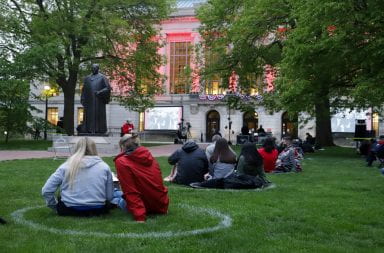There have been seven bicycle-related traffic accidents on or near Ohio State’s campus this school year, a problem some students think could be solved by adding bike lanes and more racks on campus.
Lindsay Komlanc, spokeswoman for OSU Administration and Planning, said the seven accidents occurred prior to September, and six of those accidents were collisions between bicyclists and vehicles, while one was between a bicyclist and a pedestrian.
However, The Lantern has documented at least seven pedestrian or bicycle related accidents since Aug. 20 on and off campus, at least three of which sent students to the hospital with serious injuries.
OSU President E. Gordon Gee and others think the semester switch, large freshman class of almost 7,200 new students and campus construction contributed to the spike in accidents at the start of the semester.
“I think it is because of the rhythm of change from quarters to semesters, and the fact that we are doing so much construction on campus,” Gee said. “Those are probably the two major issues.”
In a Sept. 10 interview with The Lantern, Gee described a recent time when he narrowly escaped being at the center of a bike collision.
“I was outside of Bricker Hall and someone was riding, should(n’t) have been riding on the sidewalk, and someone whizzed by me, and if I would have stepped out another step we would have had a confrontation, and I would have lost,” he said.
To prevent people from riding on the sidewalks, some students said they think there are several ways the university could help accommodate campus bicyclists.
Alex Smith, president of Bike OSU, said the university should add more bike racks on campus because it’s getting harder to find parking.
“There is a definite need for more bike parking … there needs to be more racks especially by the RPAC, (William Oxley) Thompson (Memorial) Library and the Ohio Union,” Smith said. “I have had troubles finding a spot this year more so than other years.”
Komlanc said there are a couple of options the university is looking into regarding the bike parking issue.
“Moving forward, there are a number of options being considered, including additional bike racks,” Komlanc said. “Another option being considered is moving the location of bike racks to make them easier to get to without riding on the sidewalk.”
Paige Bailey, a program assistant at the Melton Center for Jewish studies, said she rides her bike often and thinks there aren’t enough bike lanes on campus.
“I think signifying bike lanes can be very helpful,” Bailey said. “A lot of students and people just don’t know that bikes are not supposed to be on the sidewalk and they don’t feel safe on the street, so I think having marked-out lanes helps bikers feel safe and comfortable on the road.”
Some students agreed.
“I honestly think that the sidewalks shouldn’t be used for bikes,” said Chandler Wilson, a first-year in nursing. “I think that the bikers should use the streets; I mean there are streets everywhere. I’m a big biker, I don’t think it would be that difficult to use the streets. If Ohio State wanted to put in specific bike lanes I think that would be awesome. They have them on High Street and other areas of Columbus, so I think that would be a good addition to the campus community.”
Wilson also said bike racks would be helpful on campus, because they tend to be crowded when students are on campus.
Komlanc said there are very few bike lanes on campus, as the university implemented “sharrows” onto streets because they are more effective when it comes to safety for all forms of transportation. Sharrow is an nickname for “shared lane bicycle marking.”
“University streets must function for bicyclists, pedestrians, buses and cars all within a limited geographical area,” Komlanc said. “Incorporating sharrows on campus streets is part of our effort to make campus a safe place for multiple modes of travel.”
Smith said he thinks it’s important to properly educate students about bike safety, especially with the increase of bikers over the years.
“It seems as if the number of bikers increase every year,” Smith said. “Biking will increase as gas prices rise, parking gets more expensive and students that are coming out of high school today are more interested in (public) transit, walking and cycling.”
Komlanc said the bottom line is the university and student bikers need to work together to ensure traffic safety on campus.
“The biggest piece of advice for all students, faculty and staff is to personally participate in traffic safety,” Komlanc said. “Everyone needs to be aware of their surroundings and be sure they are sharing in the responsibility for traffic safety.”
Komlanc said the entire university needs to work together to reduce the number of accidents and control the problem.
“The key point to take away is that regardless of your mode of travel, all motorists, bicyclists and pedestrians have a joint responsibility to take an active role in traveling safely,” Komlanc said.
In light of accidents this fall, the university formed a safety task force that was expected to make safety recommendations to the university by Oct. 1. Those recommendations were still being finalized on Monday and had not yet been announced to the OSU community by Tuesday evening.
Grant Gannon contributed to this article.


